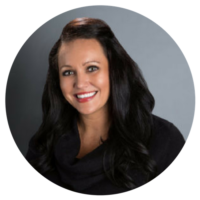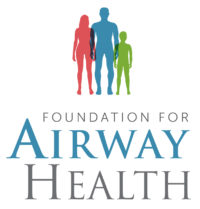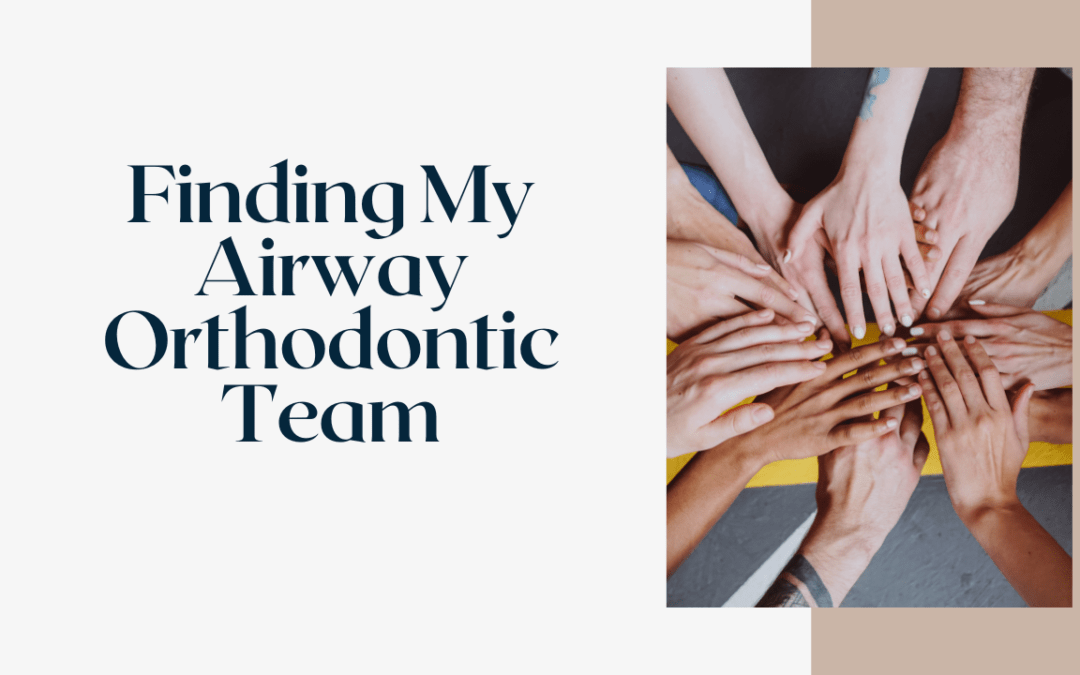When I was growing up, braces weren’t such a “right of passage” into “teenagerhood”. In fact, I was in college before my dad felt confident that I wouldn’t get my teeth knocked out on the basketball court. Just like all the other girls my age, I didn’t like crooked teeth and I wanted to get my teeth straight so that I could have a beautiful smile. I thought that braces = no more buck teeth. And I thought no more buck teeth = a date with the cute guy in my class. 😜
Unfortunately, even if I had gotten braces way back then they wouldn’t have been successful because I had a low resting tongue (no internal support for the dental arch), open mouth resting posture (no lip strength for “nature’s braces”) and mouth breathing. All of which contributed to my long, narrow face and high, narrow arch and less than ideal nasal plumbing. In those days, no one ever mentioned anything about the airway or facial development.
Never.
Nowadays, I spend hour upon hour visiting with potential clients about TMJ and airway orthodontics, sleep-disordered breathing, crooked teeth and how to get straight teeth, correctly. In my world, we don’t want “tooth beauticians”, we want airway orthodontists who understand that orthodontics shouldn’t be about straight teeth. Orthodontics should be about fixing the cause not the symptom. Orthodontics should be about preventing breathing and airway issues, not causing them.
In this article, I wanted to help you learn about finding your airway orthodontic team. It only makes sense that if I’m telling you that you need an airway orthodontic dream team that I help you pick the team correctly, right?
Shall we?
Why choose airway orthodontics?
The term airway orthodontics is not a widely understood concept, but it’s gaining traction, especially as more myofunctional therapists are being trained. Airway focused orthodontics is really a way of thinking and practicing that seeks out answers rather than just cosmetically straightening teeth. An airway focused orthodontist understands that cosmetically straightening teeth is not a healthy answer. Orthodontists with antiquated thinking believe that crowded teeth is the problem and making them look pretty is the answer. Airway orthodontics focuses on quality of life and that the human is a whole being, rather than “just a set of crowded teeth”. Airway orthodontists understand that when a person has a better airway, he or she will have a better life.
When you choose airway orthodontics you are choosing a specialist who understands that a pretty smile is secondary to a healthy airway and quality, restorative sleep. They have stopped worrying about crooked teeth, instead looking for the reason that made them crooked.
Why should you address crooked teeth?
It’s important to address crooked teeth because it is a clear sign that craniofacial development has gone awry. When the bones of the face are not developing correctly they don’t get big enough to hold all the teeth in correct alignment. This misguided craniofacial development is a sure sign that other symptoms may follow.
These symptoms may be:
-
Smaller airway
-
-
Open bite
-
Cross bite
-
-
High, narrow palate
-
-
Snoring
-
Crooked teeth are more than just a cosmetic or dental health issue (periodontal disease or tooth decay). Crooked teeth are more than just a “genetic” thing. Crooked teeth should be viewed as the “canary in the coal mine” and you should be Googling “finding my airway orthodontic team near me” as soon as you notice that the teeth are getting crowded.
Fun fact that most parents don’t know, but it takes me back to my dental hygiene days. A child is born with leeway and primate spacing. This means that a child should have gaps between all the teeth. This gap is acting like a space maintainer so that the much bigger adult tooth can come into correct alignment. If you look in your child’s mouth and see that the teeth are touching, you should already be concerned. If the little baby teeth are touching, it will be difficult if not impossible for the adult teeth to erupt without a problem.
What age should a child first visit an orthodontist?
Even though the American Orthodontic Association doesn’t recommend a screening until age 7, that may be too late to start making arch development changes in children who need it.
There isn’t a hard and fast answer to this question. I always encourage parents to watch for misguided craniofacial development and seek out an airway focused orthodontist instead of asking their general dentist or pediatrician. Often, those providers who aren’t skilled in early orthodontic treatment, are going to dispense advice that might be regretful later.
Some of the providers that I work with have started early orthodontic intervention as early as age 4 in a child who desperately needed it. If your child has some toxic oral habits, it is also important that we tackle those before attempting orthodontics because the habit will work against successful orthodontic treatment.
But what if you already know your child needs braces? It is still important to seek out early orthodontic correction and not wait until all permanent teeth have erupted. Some doctors will tell you this but it makes no sense not to make changes when your child is still developing and is bendable and pliable! You want to harness the power of arch development in a younger mouth rather than having to work at the skeletal level in an older mouth. Remember that a child’s facial development is 90% complete by the time a child is 10-12 years old, with girls maturing ahead of boys.
Who should be on my airway orthodontic team?
Your airway orthodontic dream team should consist of an experienced myofunctional therapist, “airway specialist’s” which may be your orthodontist or airway centric dentist, a functional chiropractor or physical therapist and a sleep physician.
Here at
Impact Myofunctional Therapy, we help build that team. We work with a wide network of well-vetted specialists whom we can refer you to. It truly is a team approach. Once you’ve had a comprehensive myofunctional exam then we can map out a plan to optimum health. Airway is king. We are always focused on the airway since correct airway development is crucial!
What should you expect from an airway orthodontist?
When you have an assessment with an airway focused orthodontist you should find that he or she is not just focused on the teeth. The focus should be on optimizing facial development, correcting orofacial myofunctional disorders, improving sleep and avoiding any treatment the decreases the tongue space.
This means not extracting teeth because the mouth “doesn’t have room for all the teeth”. When you extract teeth from a small mouth you make a smaller mouth (and potentially a smaller airway). The goal of airway orthodontics is to make the space bigger so all the teeth can come in straight and easily move into alignment without being stacked upon one another.
Is there airway orthodontics for adults?
Absolutely! It is just harder. Once a child transitions into mixed dentition (both baby teeth and big kid teeth) it is much harder to work on arch development. At that point the skeletal bone needs to be widened. It is possible with a lot of success, but it is not a simple and can take considerably more time.
Many adults are reversing previous orthodontic treatment that left them with a narrow and restricted airway. These adults experienced orthodontic treatment from someone who chose to extract teeth (which affects the tongue space) rather than utilizing methods to enlarge the bones to make room for all the the teeth. Many of these extraction cases are suffering from obstructive sleep apnea, poor sleep, daytime fatigue and drowsiness, chronic pain, TMJ problems, weight gain, low motivation and poor mental health.
How do I find an airway focused orthodontist?
Obviously the best way is to have an exam with us and then we can make a referral. But if you’re flying solo, then I have a few suggestions.
#1. Google “Airway Orthodontics”.
Then take it a step further and go look at the website. When it comes to the airway and correct facial development, this stuff should be front and center. If you’re having to root around for anything about airway orthodontics on a website, then that is not their speciality. If you go to a website and it’s solely focused on cosmetic procedures and tooth whitening, you can probably rest assured that sleep-apnea prevention is not the main focus. If you read a lot about cosmetically straightening teeth but see very little about sleep and airway, then the office is probably not an airway focused office.
A great example is the website of one of my favorite colleagues, Dr. James Bieneman in Littleton, Colorado. If you visit his business site,
Integrative Dental of Denver, you will see a very powerful message on the homepage. It says “We care about your dental health and overall well being. Look better. Feel better. Breathe and sleep better.” He is already addressing sleep and breathing, two things that are related to craniofacial development and the airway. Dig a bit further and click on services, where you will immediately see “airway orthodontics”, “kid’s airway orthodontics” and “adult airway orthodontics”. Dr. Bieneman makes it very clear what his priority is when you land upon his page. Use this as an example for your own research.
#2. Go meet the doctor and don’t be afraid to ask questions.
Educating yourself about the airway and airway orthodontics will help ease this conversation. Your dentist may not be one of those people operating with “the new way of thinking”. Your dentist might still be referring to the local orthodontist at age 13, just like he or she was taught in dental school. Somebody has to stand up for your child. You want your child to grow properly, and having a critical eye for the health of your child is necessary. You have to be an activist and an advocate and not be afraid to have the hard conversations or go elsewhere for second and third opinions if necessary.
Here are some questions to discuss with the orthodontist you’re interviewing to care for your child:
- How is his or her dental practice screening patients for sleep and breathing problems?
- How does he or she identify misguided craniofacial growth? Is there a root cause approach or a “just fix the problem” approach?
- Does he or she use retractive orthodontics?
- Does he or she extract teeth to fix crowding issues?
- Does he or she understand the philosophy behind airway focused orthodontics and believe in it? (You will find that passionate airway warriors will have a sparkle in their eye when talking about the philosophy, whereas others will lack the passion and poo poo it.)
If the orthodontist routinely uses extraction or retraction to solve problems, then I would encourage you to move on to another orthodontist.
How do I get started?
Booking your comprehensive exam with us will kickstart your journey. Once we’ve completed your exam and understand your goals for myofunctional therapy, then we will work alongside you to map out a path to wellness that you’re excited about! If we see a need for an airway focused orthodontist, we will help you build your airway dream team. We will also help decide who needs to be on first, second and third so we can hit a homerun for your health!




